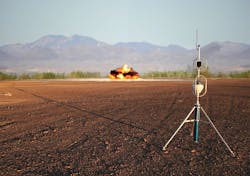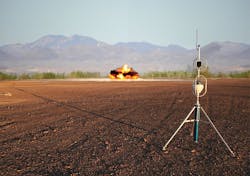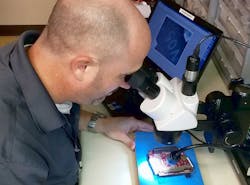Setting the standard for military ordnance detection and classification
Twenty miles off the Florida coast, U.S. Air Force personnel tested the effectiveness of air-deployed conventional munitions against swarming small boats in a test event known as Operation Maritime Strike. The multi-day event deployed live and inert ordnance from multiple aircraft types against multiple radio-frequency (RF)-controlled, high-speed boats.
For most live-fire military exercises, testing and classifying the accuracy of land- and air-based firepower is critical for assessing the effectiveness of the weapons platforms. For both land and marine-based military training operations, a series of acoustic-based ordnance detection devices developed by Trident Research are deployed across the field of operations providing soldiers and sailors with accurate, real-time scoring results.
Acoustic-based detection
“There is no other manufacturer of acoustic-based detection and scoring systems that can assess weapon effectiveness in real time as well,” says Andy Adamez, Trident’s solutions development manager. “The engineers at Trident Research have tailored a full range of omnidirectional detection and scoring capabilities that are automated and can perform in the severest of conditions on land or marine-based environments.”
At the heart of Trident’s 3-dimensional ordnance detection and scoring systems are custom printed circuit boards (PCBs) assembled by Oregon-based Screaming Circuits. Because Trident Research often tests many prototypes of its latest designs, the company relies on Screaming Circuits for its easy ordering process and their quick turnaround on short-run orders.
“Trident Research has been a loyal customer for several years,” mentions Duane Benson, Screaming Circuits marketing manager. “We understand their timing needs and are always prepared to accommodate their unique PCB requests that are integral to their acoustic sensing equipment.”
“Screaming Circuits is the perfect fit when we require fast turnaround times on custom jobs we are product testing during the prototype stage,” Adamez adds. “We're always looking for ways to improve our product line, and their online quoting and ordering system allows us to receive our custom PCBs soon after. The fact they are U.S.-based and a trusted partner also gives us confidence that our proprietary information remains secure.”
Product streamlining for faster implementation
With each new generation of weapons ordnance impact and detonation audio sensor equipment, Trident engineers review data results to find new ways to reduce operational complexity and improve the user experience of their sophisticated platforms.
“When we first launched our Realtime 2D and land-based 3D Submeter systems in 2009, the user training period took about two weeks,” Adamez describes. “Today, because of our ongoing field observations and detailed user feedback, we have streamlined the operator experience and reduced the training cycle to four days.”
Trident Research began as a result of the engineering design work being carried out for the U.S. Navy at the Applied Research Laboratories at the University of Texas at Austin (ARL:UT). For over 50 years, ARL:UT has played a leading and vital role in researching and developing acoustics and high-resolution sonar technology.
During the 1990s, ARL:UT leader, Miguel “Mike” Cardoza and his research team were innovating and developing portable impact location systems. His team’s research and development activities soon became critical for naval training purposes that could help naval personnel improve the accuracy ships weapon systems. At the time, because the lab’s primary purpose was for research, Cardoza, and his team could not produce sonar products beyond the testing stage. As a result, he and some of his fellow team members were inspired to establish Trident Research with the goal of manufacturing the most advanced acoustic-based weapons detection and scoring systems for the military.
First prototype sets pace for advancement
By 2008, Cardoza and his team had developed their first in-air prototype device for the military. A year later, Trident Research began delivering their first units including the Tactical Acoustic Realtime Geolocation and Training (TARGT™) and Terrestrial Realtime Acoustic Classification and Scoring (TRACS™) live fire testing and training systems.
Trident Research delivered its new Multi Event Automated Scoring (MEAS) system to the U.S. Army’s Yuma Proving Ground, classified as a Major Range and Test Facility Base in Arizona. Trident’s new system is designed to help display three-dimensional (3D) geodetic scoring results for multiple direct or indirect firing platforms that allow participants to accelerate their decisions when making targeting adjustments.
Today, although the U.S. military is the primary customer for the Realtime 2D and 3D Submeter systems, many of America’s closest allies have expressed interest in Trident’s weapon testing products. Back off the coast of Florida, live-fire results taken during Operation Maritime Strike have helped commanders refine their battlefield tactics during combat conditions. Trident’s acoustic-based sensors are now becoming essential training tools that instantly transmit ordnance data and improve the effectiveness of the U.S. military.
Trident Research is, according to company officials, the only company that develops and manufactures weapons testing and training instrumentation that is deployable in all weather, all terrain, combat-realistic conditions. Based in Austin, Texas, the company initially began developing real-time acoustic sensors, geo-location and computer algorithms to detect, classify and transmit real-time scoring of ordnance target impacts from single and multiple sources. Today, the full Trident product line includes systems designed to detect firing from multiple sources, including land-based muzzle flashes using infrared light detectors that integrate with its classification and scoring systems.
Article and images courtesy Trident Research. Learn more at Trident Research and at Screaming Circuits.
You might also like:
Subscribe today to receive all the latest aerospace technology and engineering news, delivered directly to your e-mail inbox twice a week (Tuesdays and Thursdays). Sign upfor your free subscription to the Intelligent Inbox e-newsletter at http://www.intelligent-aerospace.com/subscribe.html.
Connect with Intelligent Aerospace on social media: Twitter (@IntelligentAero), LinkedIn,Google+, and Instagram.


